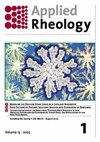评估一些已知纳米流体在五匝螺旋管流中紊流条件下的传热能力
IF 1.8
4区 工程技术
Q1 MECHANICS
引用次数: 0
摘要
本研究使用水和一些纳米流体(如 TiO2、Al2O3、Fe2O3、CuO、ZnO 和 CeO2)对螺旋管的热流行为进行了研究。使用 ANSYS 20 软件程序对螺旋盘管进行了计算流体动力学建模。使用具有标准壁面函数的 k-ε 模型模拟热流特性。采用有限体积离散法求解控制方程。研究考虑了湍流条件下流体对流体的传热情况。雷诺数、不同的纳米流体和流场布置等不同关键设计参数的影响是研究的重点。纳米流体的体积浓度为 1%。实验在不同的雷诺范围(9,000、14,000、20,000 和 25,000)下进行。发现并比较了水和纳米流体的出口温度值、传热系数、摩擦系数、努塞尔特数值。结果发现,与纳米流体相比,水的出口温度、传热系数和努塞尔特数值最低,而摩擦系数值最高。在纳米流体中,CeO 的出口温度、传热系数和努塞尔特数值最高,摩擦系数值最低。发现 TiO2 的出口温度(T out)、传热系数值和摩擦系数值最低。Al2O3 的努塞尔特数最低。此外,在水的不同迪安数(2,200、3,400、4,900、6,100、7,350 和 8,600)下获得的努塞尔特数值与之前的研究结果一致。此外,还获得了不同速度下水的摩擦系数值(0.18、0.24、0.41、0.71、0.95、1.07 和 1.18),结果与之前的研究一致。本文章由计算机程序翻译,如有差异,请以英文原文为准。
Assessment of heat transfer capabilities of some known nanofluids under turbulent flow conditions in a five-turn spiral pipe flow
In this study, the thermo-flow behaviours of the spiral tube were examined using water and some nanofluids such as TiO2 , Al2 O3 , Fe2 O3 , CuO, ZnO, and CeO2 . The computational flow dynamic modelling of the spiral coiled tube was performed with ANSYS 20 software program. The k –ε model with a standard wall function was used to simulate the thermo-flow characteristics. The solution of the governing equations was performed using the discretization method of finite volume. The study was carried out considering the case of fluid-to-fluid heat transfer in turbulent conditions. The influence of different key design parameters such as Reynolds number, different nanofluids, and flow arrangements was of main interest. The volume concentration of the nanofluids is 1%. The experiments were performed at different Reynolds ranges (9,000, 14,000, 20,000, and 25,000). The outlet temperature values, heat transfer coefficient, coefficient of friction, Nusselt number values of water, and nanofluids were found and compared. It was found that the outlet temperature, heat transfer coefficient, and Nusselt number values of water were the lowest, while the coefficient of friction value was the highest compared to the nanofluids. Among the nanofluids, CeO was found to have the highest outlet temperature, heat transfer coefficient, and Nusselt number value, as well as the lowest coefficient of friction value. TiO2 was found to have the lowest outlet temperature (T out ), the heat transfer coefficient value, and the highest coefficient of friction value. Al2 O3 was found to have the lowest Nusselt number. In addition, Nusselt number values were obtained at different Dean numbers of water (2,200, 3,400, 4,900, 6,100, 7,350, and 8,600) and found to be compatible with previous studies. In addition, the coefficients of friction values of water at different velocities (0.18, 0.24, 0.41, 0.71, 0.95, 1.07, and 1.18) were obtained and found to be compatible with previous studies.
求助全文
通过发布文献求助,成功后即可免费获取论文全文。
去求助
来源期刊

Applied Rheology
物理-力学
CiteScore
3.00
自引率
5.60%
发文量
7
审稿时长
>12 weeks
期刊介绍:
Applied Rheology is a peer-reviewed, open access, electronic journal devoted to the publication in the field of applied rheology. The journal provides the readers with free, instant, and permanent access to all content worldwide; and the authors with extensive promotion of published articles, long-time preservation, language-correction services, no space constraints and immediate publication.
 求助内容:
求助内容: 应助结果提醒方式:
应助结果提醒方式:


